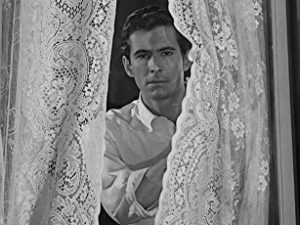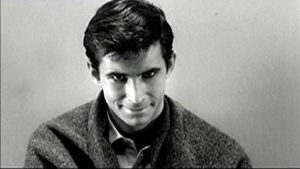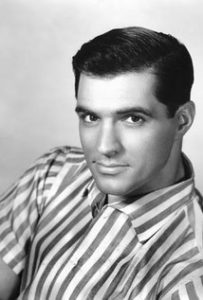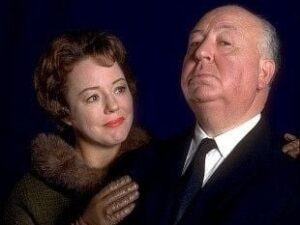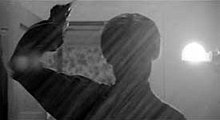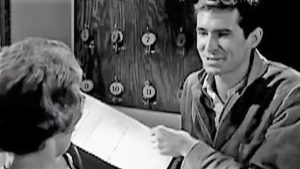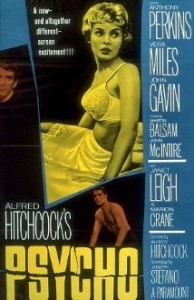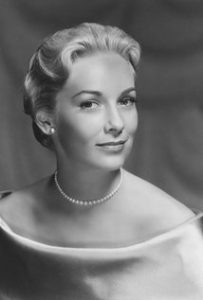Psycho ***** (1960, Anthony Perkins, Janet Leigh, Vera Miles, John Gavin, Patricia Hitchcock, Martin Balsam, John McIntire, Lurene Tuttle) – Classic Movie Review 8
‘Do you have any vacancies?’ ‘Oh, we have 12 vacancies. 12 cabins, 12 vacancies.’
Alfred Hitchcock’s once dreaded and despised nail-biting 1960 horror classic Psycho had people boycotting it in fear at the cinema and eventually hiding in terror behind their sofas when it was shown on TV. Walt Disney himself called it ‘that disgusting movie’. But it is now relished and admired everywhere as an inspired pure-cinema chiller masterpiece of intelligent thrills and suspense – and endlessly reworked, copied or used as a template for inferior movies.
In the role she will always be remembered for, Janet Leigh is astonishingly charismatic and authoritative in an electric performance as Marion Crane, the young secretary impulsively fleeing from Phoenix, Arizona, with an envelope of money belonging to her boss’s client. It’s $40,000 ($315,000 in today’s money).
She is supposed to take it to the bank but instead just she drives off in her 1957 Ford sedan with it to a new, better, richer life at her boyfriend Sam’s store in Fairvale, California. But, on the way, she starts to feel guilty and scared of getting caught. Exhausted and caught in a blinding rainstorm on a dirty night, she heads off the main road and fatefully pulls over at the remote and eerie Bates Motel.
There she is greeted by a young, handsome and sympathetic if distinctly nervous-seeming Anthony Perkins, also giving a career-best turn, as the magnificently tormented, twitchy and mother-fixated hotel keeper Norman Bates (‘a boy’s best friend is his mother’). Two career-best performances: it is an amusing irony that Hitchcock, who infamously called actors ‘cattle’, nevertheless always brought out the best in his actors.
The director found to his dismay that there was total studio resistance to the project – this wasn’t the kind of movie they understood at all, so Hitch put up his own money, even mortgaging his house to finance it. Always the ultimate showman, he understood public taste far better than the old-style Hollywood moguls. The gamble paid off big time: an $806,000 movie took more than $40 million at the box office, including a $32 million US gross, a nice little earner. The cumulative worldwide gross was estimated at $50 million on 31 January 2004.
With initial question marks over the movie’s financial prospects, a fired-up Hitchcock went to work filming briskly (in just 30 days) and cheaply in black and white in the style of his then current TV series, Alfred Hitchcock Presents. What was it that most fascinated him: the black humour, the red herrings, the popular psychiatry, the technical challenges, upsetting his critics, scaring the public, or in seeing just how far he could push the boundaries in shocking his audience?
You would think a film that depends on tension, shocks and surprises would only work its magic once, but not so: it still grips after any number of viewings. It’s the director’s show, but praise too for title designer and artistic consultant Saul Bass who (allegedly) probably filmed the shower sequence, John L Russell for the sharp, crisp black and white photography and Bernard Herrmann for the famous vintage string-dominated score (‘33 per cent of the effect of Psycho is due to the music’, said Hitch.)
I haven’t mentioned the screenplay. Fascinated by the story of the real-life American serial killer Ed Gein that also inspired The Silence of the Lambs, Hitch bought the rights to Robert Bloch’s Gein-inspired novel (anonymously, so he only paid a measly $9,000), and hired young writer Joseph Stefano to write the script: it was his crucial idea to pump up the focus on the fate of Marion Crane. It was only Stefano’s second screenplay (after The Black Orchid in 1958), and a masterpiece, of a level he could never achieve again.
And the acting is spot-on throughout too: it’s like ice and fire, you can feel it radiating off the screen, not only by Perkins and Leigh, but also John Gavin as Marion Crane’s illicit lover Sam, Vera Miles as her investigating sister Lila, Patricia [Pat] Hitchcock as her co-worker Caroline, Martin Balsam as the sweaty detective Arbogast, John McIntire as the local sheriff Al Chambers, Lurene Tuttle as his wife, Mort Mills as the creepy highway patrol officer, Frank Albertson as Tom Cassidy, Vaughn Taylor as George Lowery, John Anderson as California Charlie and Simon Oakland as the doctor, Fred Richman.
Many of them don’t have too much to do, but they make every second count. Leigh’s 25 minutes on celluloid in Psycho are her ticket to posterity, just as Perkins’s 90 minutes here are too. And, in some ways, its entire blissful 109 minutes are Hitch’s claim to eternal fame too. In his usual cameo, six minutes into the movie, he is seen through the office window wearing a Stetson cowboy hat, just as Janet Leigh is about to come through the door.
Jeanette Nolan (uncredited) provides the voice of Norma Bates.
All of today’s horror films start from this point and owe a debt to Psycho, it is that important and influential. But best of all, it is just plain brilliant in itself. Helped by the gleaming black and white images, it is still strangely undated and ‘modern’. It seems so freshly minted that it is a shock to realise that it is way over 50 years old.
Three much lesser sequels followed, Psycho II, Psycho III and Psycho IV, all with Perkins (and one directed by him) who simply could never shake the role off he was so closely identified with it, and it was faithfully (and pointlessly) remade as Psycho in 1998 in colour by Gus van Sant. The 2012 film Hitchcock with Anthony Hopkins centres on the filming of Psycho. And now there is a TV series, Bates Motel (2013–2017).
Director Alexandre O Philippe dissects the Psycho shower murder scene to riveting effect in the documentary feature 78/52 (2017).
Psycho is directed by Alfred Hitchcock, runs 109 minutes, is made by Shamley Productions, is released by Paramount, is written by Joseph Stefano, based on the novel by Robert Bloch, is shot in black and white by John L Russell, is produced by Alfred Hitchcock and is scored by Bernard Herrmann, with Art Direction by Robert Clatworthy and Joseph Hurley and Film Editing by George Tomasini.
Ever the innovator, Hitchcock advertised it like this: ‘No One … BUT NO ONE … Will Be Admitted To The Theatre After The Start Of Each Performance Of Alfred Hitchcock’s Psycho.’ Previously, patrons used to wander in and out of cinemas freely, but this accidentally started the trend of having separate performances for movies.
Ever the mean producer, Hitchcock paid Perkins only $40,000 for his star role, ironically the same amount of money Marion Crane tries to steal.
Patricia Hitchcock also appears in Hitchcock’s Stage Fright (1950) and Strangers on a Train, her most substantial appearance. Patricia also appeared in ten episodes of her father’s half-hour TV show Alfred Hitchcock Presents. She was also an extra in her father’s film Sabotage (1936) in the crowd with her mother Alma Reville waiting for and then watching the Lord Mayor’s Show parade.
RIP John Gavin, star of Psycho, Douglas Sirk’s Imitation of Life, Kubrick’s Spartacus and Thoroughly Modern Millie (1967), who died on 9 aged 86. He won a Golden Globe as Most Promising Newcomer – Male for A Time to Love and a Time to Die (1958).
RIP Patricia Alma O’Connell, born in London as Patricia Hitchcock on 7 July 1928, the only child of Alfred Hitchcock and Alma Reville. She died on 9 August 2021, at home in Thousand Oaks, California, aged 93. Her daughter Teresa Carruba said her mother died in her sleep from natural causes: ‘She was always really good at protecting the legacy of my grandparents and making sure they were always remembered.’
http://derekwinnert.com/north-by-northwest-classic-film-review-4/
http://derekwinnert.com/the-39-steps-classic-film-review-119/
© Derek Winnert 2013 Classic Movie Review 8
Check out more reviews on http://derekwinnert.com/

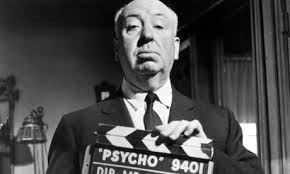
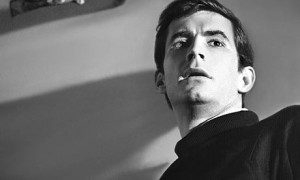

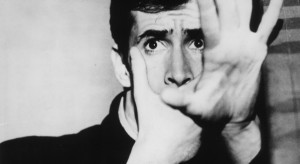

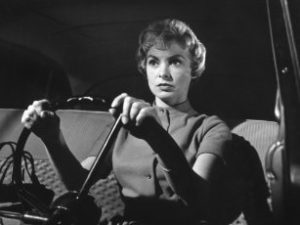

![Cameo-Psycho-295px[1]](http://derekwinnert.com/wp-content/uploads/2013/09/Cameo-Psycho-295px1.jpg)
